
GWEDE Mantashe, South African mines minister, has in 18 months done a great deal to improve his government’s relationship with the local mining sector – a contribution recognised by Neal Froneman, CEO of Sibanye-Stillwater. “We have found a lot of common ground with our minister and his department,” Froneman said in June in an interview.
Mantashe’s 2019 Mining Charter, a redraft of predecessor Mosebenzi Zwane’s version, which the Minerals Council described as egregious, played a significant role in helping restore the relationship between the private sector and Mantashe’s department (DMRE).
So it’s with some irony that on Tuesday Mantashe targeted Sibanye-Stillwater as having failed to comply with the Mining Charter. His complaint is that Sibanye-Stillwater unlawfully claimed credits for an empowerment deal, the sale of a 15% stake in Beatrix to Mvelaphanda Resources in 2009.
The subsidiary that housed Beatrix, as well as Driefontein and Kloof, was de-merged by Gold Fields to create Sibanye Gold in 2012. Sibanye-Stillwater’s legal defence is that the subsidiary has the empowerment points, not Gold Fields. The subsidiary is the basis for Sibanye-Stillwater’s gold division: ergo, Sibanye-Stillwater is directly empowered.
Mantashe’s argument speaks to his long-running contention that empowerment transactions shouldn’t be held in perpetuity. This view has been defeated in court, but the DMRE intends to contest the matter as it applies to the 2010 iteration of the Charter.
Here, though, is the problem. The DMRE is forever seeking to penalise the mining sector instead of incentivising it. Why can’t government’s focus fall squarely on future good such as the new exploration strategy it has laudably promised to roll out next year, including investment in an upgraded and transparent mining cadastre?
Instead, Mantashe is cavilling technical, backward-looking matters.
Beatrix has a maximum 10 years left of operation assuming the new mining right is awarded by the DMRE. Why would Sibanye-Stillwater accept the economic penalty of re-empowering a short life asset, and what black industrialist ought to participate in such a scheme? Better to close the mine, even if it means jobs.











